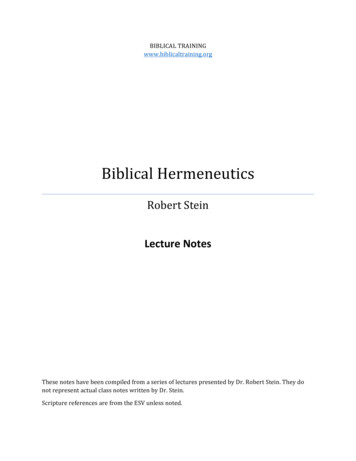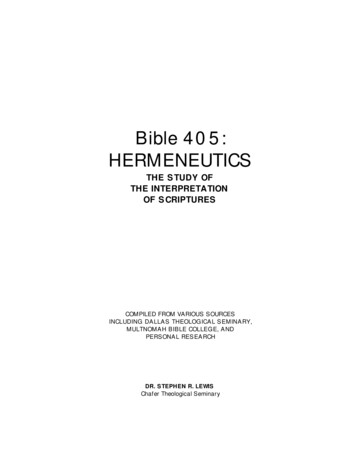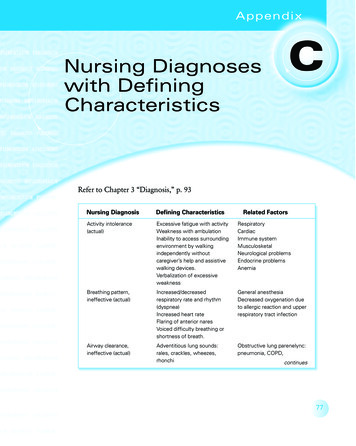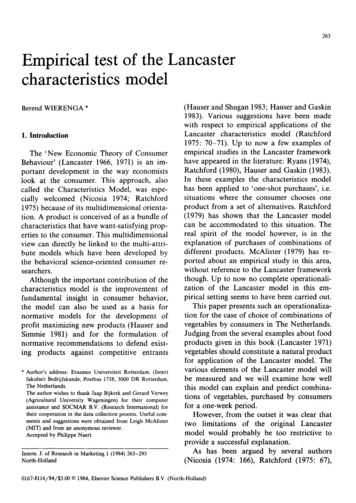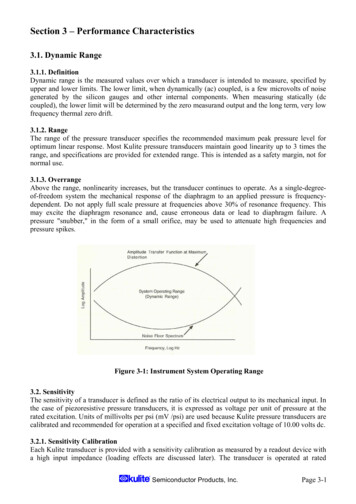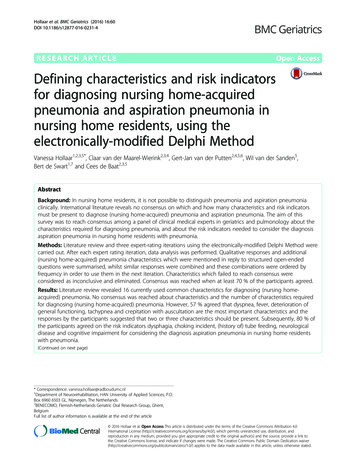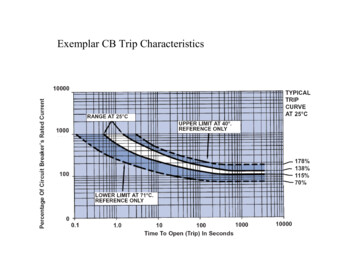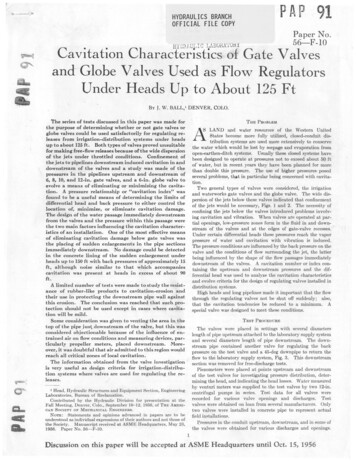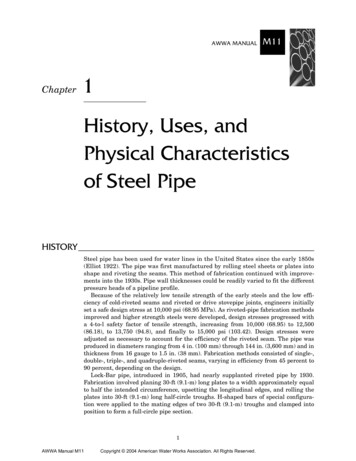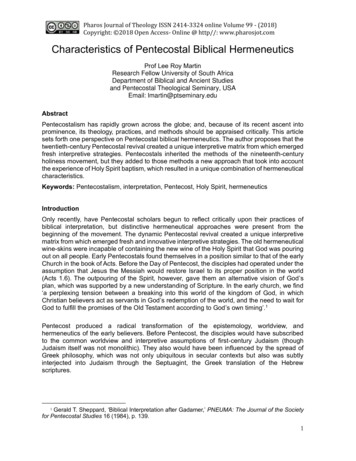
Transcription
Pharos Journal of Theology ISSN 2414-3324 online Volume 99 - (2018)Copyright: 2018 Open Access- Online @ http//: www.pharosjot.comCharacteristics of Pentecostal Biblical HermeneuticsProf Lee Roy MartinResearch Fellow University of South AfricaDepartment of Biblical and Ancient Studiesand Pentecostal Theological Seminary, USAEmail: lmartin@ptseminary.eduAbstractPentecostalism has rapidly grown across the globe; and, because of its recent ascent intoprominence, its theology, practices, and methods should be appraised critically. This articlesets forth one perspective on Pentecostal biblical hermeneutics. The author proposes that thetwentieth-century Pentecostal revival created a unique interpretive matrix from which emergedfresh interpretive strategies. Pentecostals inherited the methods of the nineteenth-centuryholiness movement, but they added to those methods a new approach that took into accountthe experience of Holy Spirit baptism, which resulted in a unique combination of hermeneuticalcharacteristics.Keywords: Pentecostalism, interpretation, Pentecost, Holy Spirit, hermeneuticsIntroductionOnly recently, have Pentecostal scholars begun to reflect critically upon their practices ofbiblical interpretation, but distinctive hermeneutical approaches were present from thebeginning of the movement. The dynamic Pentecostal revival created a unique interpretivematrix from which emerged fresh and innovative interpretive strategies. The old hermeneuticalwine-skins were incapable of containing the new wine of the Holy Spirit that God was pouringout on all people. Early Pentecostals found themselves in a position similar to that of the earlyChurch in the book of Acts. Before the Day of Pentecost, the disciples had operated under theassumption that Jesus the Messiah would restore Israel to its proper position in the world(Acts 1.6). The outpouring of the Spirit, however, gave them an alternative vision of God’splan, which was supported by a new understanding of Scripture. In the early church, we find‘a perplexing tension between a breaking into this world of the kingdom of God, in whichChristian believers act as servants in God’s redemption of the world, and the need to wait forGod to fulfill the promises of the Old Testament according to God’s own timing’.1Pentecost produced a radical transformation of the epistemology, worldview, andhermeneutics of the early believers. Before Pentecost, the disciples would have subscribedto the common worldview and interpretive assumptions of first-century Judaism (thoughJudaism itself was not monolithic). They also would have been influenced by the spread ofGreek philosophy, which was not only ubiquitous in secular contexts but also was subtlyinterjected into Judaism through the Septuagint, the Greek translation of the Hebrewscriptures.1 Gerald T. Sheppard, ‘Biblical Interpretation after Gadamer,’ PNEUMA: The Journal of the Societyfor Pentecostal Studies 16 (1984), p. 139.1
Pharos Journal of Theology ISSN 2414-3324 online Volume 99 - (2018)Copyright: 2018 Open Access- Online @ http//: www.pharosjot.comThe hermeneutics of the apostles changed on the Day of Pentecost.2 Although they continuedto utilize many standard Jewish exegetical practices, their approach to biblical interpretationwas altered by at least four new contextual factors: 1. the life, teachings, and resurrection ofJesus; 2. the gift of the Holy Spirit poured out on the Day of Pentecost; 3. the mission of thespreading the gospel, which demanded that the disciples go with haste into the world; 4. theeschatological nature of Jesus’ kingdom, which required the disciples to wait patiently for thereturn of Jesus.3In its radical re-ordering of reality, Pentecost might be compared to the divine encounters ofthe Old Testament prophets in their call narratives. The prophetic experience was anapocalyptic event that deconstructed previously held assumptions and created newtheological perceptions and new possibilities for God’s people.4 Just as Moses was reborn atthe burning bush, just as Israel was transformed at Mt. Sinai, and just as Isaiah was reshapedby his vision, so also the early disciples were changed at Pentecost. The comparison betweenPentecost and the prophetic calling is strengthened further by Peter’s interpretation ofPentecost as the fulfillment of Joel’s promise that servants, sons, daughters, old, and young‘will prophesy’ (Acts 2.17). Therefore, the gift of the Spirit is the gift of prophecy; and,consequently, Pentecost creates a community of prophets.5 As John McKay has argued, theprophetic gift of the Spirit naturally leads to the prophetic interpretation of Scripture.6 Thesermons in the book of Acts as well as the New Testament documents demonstrate theoutworking of that prophetic hermeneutic.Like the early church, the first Pentecostals inherited a set of interpretive presuppositions; butwhile the apostles had been shaped by the hermeneutical assumptions of Judaism, the earlyPentecostal movement was indebted to the conservative hermeneutical approaches of thelate nineteenth century. The Pentecostal movement emerged from a religious context thatincluded the holiness movement, the healing movement, restorationist movements,revivalism, and millenarian movements, 7 all of which carried ramifications for biblicalinterpretation. Pentecostals, for the most part, practiced theCf. Sheppard, ‘Biblical Interpretation after Gadamer,’ p. 132.Sheppard sees the tension between ‘hurrying and waiting,’ along with the ‘passionate personalexperiences of the Holy Spirit, as the two features that form the ‘heart of the Pentecostal tradition’(Sheppard, ‘Biblical Interpretation after Gadamer,’ p. 140).4 See Rick D. Moore, ‘The Prophetic Calling: An Old Testament Profile and Its Relevance for Today,’Journal of the European Pentecostal Theological Association 24 (2004), pp. 18-21.5 See Roger Stronstad, The Prophethood of All Believers: A Study in Luke’s Charismatic Theology(Cleveland, TN: CPT Press, 2010).6 John W. McKay, ‘When the Veil Is Taken Away: The Impact of Prophetic Experience on BiblicalInterpretation,’ Journal of Pentecostal Theology 5 (1994), pp. 24-32. Cf. Larry R. McQueen, Joel andthe Spirit: The Cry of a Prophetic Hermeneutic (Cleveland, TN: CPT Press, 2009).7 Kenneth J. Archer, A Pentecostal Hermeneutic: Spirit, Scripture and Community (Cleveland, TN:CPT Press, 2009), p. 99. Cf. Jean-Daniel Plüss, ‘Azusa and Other Myths: The Long and Winding Roadfrom Experience to Stated Belief and Back Again,’ PNEUMA: The Journal of the Society for PentecostalStudies 15.2 (1983), p. 191. For the impact of millenarian movements on Pentecostalism, see GrantWacker, ‘Functions of Faith in Primitive Pentecostalism,’ Harvard Theological Review 77 (1984), pp.369-73.232
Pharos Journal of Theology ISSN 2414-3324 online Volume 99 - (2018)Copyright: 2018 Open Access- Online @ http//: www.pharosjot.comcommon populist ‘common sense approach’8 that took the Bible at face value. They read theBible literally,9 collapsing the distance between the original context of Scripture andthe context of the reader. Kenneth Archer identifies this early Pentecostal approach as ‘theBible reading method’, 10 a method that consisted in searching the Bible for all Scripturereferences to a particular subject and then synthesizing those references into a theologicalstatement. It is a harmonizing and deductive method.11Also like the early church, the first Pentecostals found it necessary to revise theirhermeneutics in light of their Pentecostal experience of the Spirit. 12 The baptism in the HolySpirit was an apocalyptic inbreaking of God that altered their worldview. Jackie Johns writes,‘At the core of the Pentecostal worldview is affective experience of God which generates anapocalyptic horizon for reading reality’.13 Consequently, the addition of the baptism in the HolySpirit to the aforementioned context of beliefs and experiences produced more than anaddendum to conservative theology and hermeneutics; it transformed every element andshaped them into a new whole, which has been called the ‘Full Gospel’ or the ‘Five-foldGospel’.14 As the ‘central defining characteristic of the Pentecostal movement’,15 the Five-foldGospel places Jesus at the center of Pentecostal theology and insists that Jesus is savior,sanctifier, Spirit baptizer, healer, and soon coming king. The Five-fold Gospel is ‘thetheological grid’ that ‘provided a firm interpretive lens for the fluid Pentecostal community andtheir reading of Scripture’.Spirit baptism and the resultant Five-fold Gospel did not entirely negate the previously heldtheological commitments and hermeneutical assumptions of the early Pentecostals, but the8 Stephen R. Graham, ‘“Thus Saith the Lord”: Biblical Hermeneutics in the Early PentecostalMovement,’ Ex auditu 12 (1996), p. 124.9 Russell P. Spittler, ‘Are Pentecostals and Charismatics Fundamentalists? A Review of AmericanUses of These Categories,’ in Karla Poewe (ed.) Charismatic Christianity as a Global Culture(Columbia, SC: University of South Carolina Press, 1994), pp. 111-12. Cf. Wacker, ‘Functions of Faith,’who observes that the practice of snake handling is a result of literalism (p. 366). Early Pentecostalinterpretation is described as ‘precritical’ by Archer, A Pentecostal Hermeneutic, p. 125; and by TimothyB. Cargal, ‘Beyond the Fundamentalist-Modernist Controversy: Pentecostals and Hermeneutics in aPostmodern Age,’ PNEUMA: The Journal of the Society for Pentecostal Studies 15 (1993), pp. 165,170-71. Archer, however, prefers to describe Pentecostals as ‘paramodern’ (A PentecostalHermeneutic, pp. 28-45), a term that Archer attributes to Jackie Johns (p. 45, n. 137). Sheppard,however, suggests the term ‘sub modern’ (‘Biblical Interpretation after Gadamer,’ p. 127).10 Archer, A Pentecostal Hermeneutic, pp. 99-127.11 Archer, A Pentecostal Hermeneutic, p. 102. Although a concordance was often used to gather thebiblical references, the method was simplified by the use of ‘chain reference’ study Bibles that linkedone verse to another through the use of marginal notation systems. The Bible reading method alsoformed the basis of reference works in which the Bible verses had already been collected into topicalcategories. One of the most popular of these was Orville J. Nave, Nave’s Topical Bible: A Digest of theHoly Scriptures (Lincoln, NE: Topical Bible Publishing Co., 1903).12 Cf. Steven Jack Land, Pentecostal Spirituality: A Passion for the Kingdom (Cleveland, TN: CPTPress, 2010), pp. 1-9.13 Jackie David Johns, ‘Pentecostalism and the Postmodern Worldview,’ Journal of PentecostalTheology 7 (1995), p. 87.14 Land, Pentecostal Spirituality, pp. 6, 38. Some non-Wesleyan Pentecostals omit sanctificationfrom the formulation, which results in a ‘Four-fold Gospel’ or a ‘Foursquare Gospel’.15 M. Nel, ‘Pentecostals’ Reading of the Old Testament,’ Verbum et Ecclesia 28.2 (2007), pp. 526-27.3
Pharos Journal of Theology ISSN 2414-3324 online Volume 99 - (2018)Copyright: 2018 Open Access- Online @ http//: www.pharosjot.comnew formulation of beliefs and affections generated subtle (and not so subtle) alterations ofolder, established paradigms. Although early Pentecostals were by no means monolithic intheir approaches, there was a ‘fundamental’ difference betweenPentecostal and non-Pentecostal hermeneutics. 16 The hermeneutical paradigm thatdeveloped in early Pentecostalism can be described in a variety of ways, but I would suggestseveral significant characteristics.First, early Pentecostals viewed the Bible as a single unified narrative of God’s redemptiveplan, whose central message may be summarized in the Five-fold Gospel. 17 Herholdtexplains:Thus, the purpose of the Bible is to bring humanity into harmony with God’s salvificpurposes and here I mean salvation and a comprehensive sense of making all thingsnew and whole. Consequently, interpretation of the Bible serves understanding, andunderstanding is part of the process of becoming whole Thus the interpretation of theBible is part of a process that answers to the criteria of becoming whole and all that itentails.18As heirs of the restorationist movements, the Pentecostals believed that the gift of the Spiritwas an indispensible characteristic of the true Church that must be experienced incontemporary times. The doctrine of justification by faith had been restored by theReformation; sanctification had been restored by Wesleyanism; divine healing had beenrestored by the healing movement; and belief in the return of Jesus had been restored by themillenarian movements. Spirit baptism was the last piece of the puzzle, completing therestoration of primitive Christianity and preparing the bride of Christ for his return. Thetwentieth-century restoration of Spirit baptism to the Church came in fulfillment of Joel’sprophecy that God would pour out both the ‘early rain’ and the ‘latter rain’ (Joel 2.23). Theearly rain fell on the Day of Pentecost and the latter rain began to fall during the Pentecostalrevival and will continue to fall until Jesus comes.19Second, viewing the Bible as one grand unified story led the Pentecostals to utilizeintertextuality as ‘a justifying mark of a faithful reading’.20 The above-mentioned Bible readingmethod was a way of tracing Pentecostal themes from Genesis to Revelation. ‘They foundthemselves called to work their way along the “figural pathways of a biblical text” so that forthem the event of scriptural interpretation was itself always a kind of exodus, a pilgrimage, ajourney into God’.21Third, the Pentecostals’ appreciation for the narrative quality of Scripture meant that theybecame a part of the story. Therefore, they no longer looked at the Bible from the outside;Nel, ‘Pentecostals’ Reading of the Old Testament,’ p. 525.Like all conservative groups, Pentecostals assumed the inspiration and authority of Scripture. SeeRenea Brathwaite, ‘Seymour on Scripture’ (38th Annual Meeting of the Society for Pentecostal Studies;Virginia Beach, VA; Feb. 29-Mar. 3, 2012), pp. 12-17.18 Herholdt, ‘Pentecostal and Charismatic Hermeneutics,’ p. 425.19 See Archer, A Pentecostal Hermeneutic, pp. 136-49; and Graham, ‘“Thus Saith the Lord”: BiblicalHermeneutics in the Early Pentecostal Movement,’ p. 127.20 Chris E.W. Green, ‘“Treasures Old and New”: Reading the Old Testament with Early PentecostalMothers and Fathers’ (41st Annual Meeting of the Society for Pentecostal Studies, Virginia Beach, VA,Mar. 29-Apr. 3, 2012), p. 15.21 Green, ‘“Treasures Old and New”,’ p. 15.16174
Pharos Journal of Theology ISSN 2414-3324 online Volume 99 - (2018)Copyright: 2018 Open Access- Online @ http//: www.pharosjot.cominstead, they entered the world of the Bible, and the world of the Bible shaped their world. 22At a time when modern scholarship (both liberal and conservative) excluded considerationof the supernatural and personal experience from the legitimate means for measuring truthclaims,23 the Pentecostals were testifying to ongoing experiences of the supernatural in theform of healings, miracles, and the charismata. According to Grant Wacker, ‘Pentecostalismoffered invincible certitude that the supernatural claims of the gospel were really true, not theold-fashioned gospel of the 19th century, but the awesome, wonderworking gospel of the firstcentury’.24 Furthermore, the Pentecostal experience altered their epistemology, giving them‘existential awareness of the miraculous in the Biblical world view’.25Fourth, the Pentecostal experience of the supernatural not only affirmed the truthfulness ofthe supernatural components of the biblical story, but it also suggested a broader approach toknowing the truth. The charismata often included an element of divine revelation, andPentecostals soon realized that the same Holy Spirit who moved upon the prophets to writeHoly Scripture (2 Pet. 1.21) could move upon them to reveal the meaning of Scripture as well.For Pentecostals, the role of the Holy Spirit in biblical interpretation goes beyond the reformedconcept of ‘illumination’.26 According to Cargal, Pentecostalism’s ‘emphasis upon the role ofthe Spirit in interpreting/appropriating the multiple meanings of the biblical texts is an importantcontribution as the Western church seeks to reclaim its sense of mysticism and theimmanence of the transcendent which was diminished by rationalism’.27Furthermore, Russell Spittler argues that even though both Pentecostals and Fundamentalistspursued a literal approach to the Bible, the Pentecostal criteria for truth was somewhatdifferent. The fundamentalist approach is based on rationalism whereas, in the Pentecostalapproach, religious experience is more valuable than human reason.28 ‘The truthfulness ofScripture’, writes Kenneth Archer, ‘was discovered relationally, personally, and experientiallymore so than “scientifically”’.29 Like the early Church in Acts 15, the first Pentecostals includedtheir own experiences as a means of discerning the guidance of the Holy Spirit. 30 Spittlerwrites, ‘Fundamentalists and neo-orthodox Christians mount arguments Pentecostals givetestimonies There is a22 H.M. Ervin, ‘Hermeneutics: A Pentecostal Option,’ PNEUMA: The Journal of the Society forPentecostal Studies 3 (1981), p. 22. Cf. McKay, ‘When the Veil Is Taken Away,’ who likens biblicalinterpretation to the production of a drama, which includes the actors on stage and the critics in theaudience. Biblical scholars are equivalent to the drama critics, who examine but do not participate.Pentecostals, however, are like the actors, who get on stage and enter into the story (pp. 32-35).23 See Sheppard, ‘Biblical Interpretation after Gadamer,’ pp. 125-26. Sheppard argues that bothliberals and Fundamentalists, ‘because they both laid claim to the same historicism and theory ofintentionality, represent’ modernity (p. 126).24 Wacker, ‘Functions of Faith,’ p. 361. Cf. Archer, A Pentecostal Hermeneutic, p. 95.25 Ervin, ‘Hermeneutics: A Pentecostal Option,’ p. 24. On the role of experience in Pentecostalhermeneutics, see Cargal, ‘Beyond the Fundamentalist-Modernist Controversy,’ pp. 178-81; and RogerStronstad, ‘Pentecostal Experience and Hermeneutics,’ Paraclete 26 (1992), pp. 14-30.26 See John Christopher Thomas, ‘Women, Pentecostalism and the Bible: An Experiment inPentecostal Hermeneutics,’ Journal of Pentecostal Theology 5 (1994), p. 49, 55; and French L.Arrington, ‘Hermeneutics,’ in Stanley M. Burgess and Gary B. McGee (eds.), DPCM (Grand Rapids,MI: Eerdmans, 1988), p. 382.27 Cargal, ‘Beyond the Fundamentalist-Modernist Controversy,’ p. 186.28 Spittler, ‘Are Pentecostals and Charismatics Fundamentalists? A Review of American Uses ofThese Categories,’ p. 108.29 Archer, A Pentecostal Hermeneutic, p. 97.30 See Thomas, ‘Women, Pentecostalism and the Bible,’ pp. 41-56.5
Pharos Journal of Theology ISSN 2414-3324 online Volume 99 - (2018)Copyright: 2018 Open Access- Online @ http//: www.pharosjot.comprofound difference between the cognitive fundamentalist and the experiential Pentecostal’.31Fifth, viewing the Bible as a lived story led also to a theological approach to narrative parts ofthe Bible.32 That is, biblical narratives were seen as examples that the Church should follow,and the book of Acts, in particular, became the ideal model for the true Church. 33 After all, ifeven the Old Testament stories are ‘examples written for our admonition, upon whom theends of the ages have come’ (1 Cor. 10.11); and if all believers are to do the ‘works’ of Jesus(Jn. 12.14), who is our ‘example’ (1 Pet. 2.21), then surely the story of the early Church in thebook of Acts must be a pattern that we should follow. ‘These narratives are understood literally,and taken to be repeatable and expected, and Biblical characters’ experiences are to beemulated. In this way Pentecostalism shares the primitivism of movements such asMontanism and the Anabaptists’.34Sixth, for Pentecostals, the biblical story has its beginning, center, and goa
The Bible reading method also formed the basis of reference works in which the Bible verses had already been collected into topical categories. One of the most popular of these was Orville J. Nave, Nave’s Topical Bible: A Digest of the Holy Scriptures (Lincoln,
